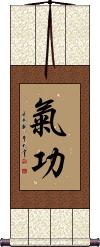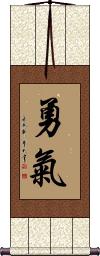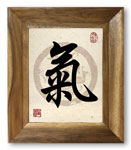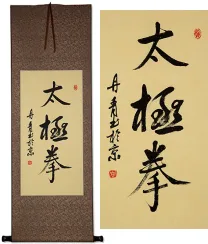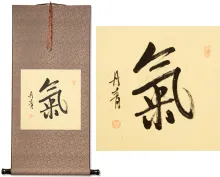Many custom options...
And formats...

Not what you want?
Try other similar-meaning words, fewer words, or just one word.
Qi Chi in Chinese / Japanese...
Buy a Qi Chi calligraphy wall scroll here!
Personalize your custom “Qi Chi” project by clicking the button next to your favorite “Qi Chi” title below...
Qi Gong / Chi Kung
氣功 or Qigong is the title of a technique that is somewhere between medical practice, meditation, and in some cases, religion.
The definition is blurred depending on which school of Qigong you are following. In some cases, it is even incorporated with martial arts.
Some people (even Chinese people) mix this title with Tai Chi (Tai Qi) exercises.
Lately, in China, people will claim to practice Tai Chi rather than Qigong because the Qigong title was recently used as a cover for an illegal pseudo-religious movement in China with the initials F.G. or F.D. (I can not write those names here for fear of our website being banned in China).
You can learn those names and more here: Further info about Qigong
If you are wondering why I wrote “Qi Gong” and “Chi Kung” as the title of this calligraphy entry, I should teach you a little about the various ways in which Chinese can be Romanized. One form writes this as “Chi Kung” or “Chikung” (Taiwan). In the mainland and elsewhere, it is Romanized as “Qi Gong” or “Qigong.” The pronunciation is the same in Taiwan, mainland, and Singapore Mandarin. Neither Romanization is exactly like English. If you want to know how to say this with English rules, it would be something like “Chee Gong” (but the “gong” has a vowel sound like the “O” in “go”).
Romanization is a really confusing topic and has caused many Chinese words to be mispronounced in the west. One example is “Kung Pao Chicken,” which should actually be more like “Gong Bao” with the “O” sounding like “oh” for both characters. Neither the Romanization system in Taiwan nor the Mainland is perfect, in my opinion, and leads to many misunderstandings.
In modern Japan, you may see this written as 気功, but the original 氣功 is still recognized. If you need the Japanese version, please contact me.
Life Energy / Spiritual Energy
Chi Energy: Essence of Life / Energy Flow
This 氣 energy flow is a fundamental concept of traditional Asian culture.
氣 is romanized as “Qi” or “Chi” in Chinese, “Gi” in Korean, and “Ki” in Japanese.
Chi is believed to be part of everything that exists, as in “life force” or “spiritual energy.” It is most often translated as “energy flow” or literally as “air” or “breath.” Some people will simply translate this as “spirit,” but you must consider the kind of spirit we're talking about. I think this is weighted more toward energy than spirit.
The character itself is a representation of steam (or breath) rising from rice. To clarify, the character for rice looks like this: ![]()
Steam was apparently seen as visual evidence of the release of “life energy” when this concept was first developed. The Qi / Chi / Ki character is still used in compound words to mean steam or vapor.
The etymology of this character is a bit complicated. It's suggested that the first form of this character from bronze script (about 2500 years ago) looked like these samples: 

However, it was easy to confuse this with the character for the number three. So the rice radical was added by 221 B.C. (the exact time of this change is debated). This first version with the rice radical looks like this: 
The idea of Qi / Chi / Ki is really a philosophical concept. It's often used to refer to the “flow” of metaphysical energy that sustains living beings. Yet there is much debate that has continued for thousands of years as to whether Qi / Chi / Ki is pure energy or consists partially or fully of matter.
You can also see the character for Qi / Chi / Ki in common compound words such as Tai Chi / Tai Qi, Aikido, Reiki, and Qi Gong / Chi Kung.
In the modern Japanese Kanji, the rice radical has been changed into two strokes that form an X.
![]() The original and traditional Chinese form is still understood in Japanese, but we can also offer that modern Kanji form in our custom calligraphy. If you want this Japanese Kanji, please click on the character to the right instead of the “Select and Customize” button above.
The original and traditional Chinese form is still understood in Japanese, but we can also offer that modern Kanji form in our custom calligraphy. If you want this Japanese Kanji, please click on the character to the right instead of the “Select and Customize” button above.
More language notes: This is pronounced like “chee” in Mandarin Chinese, and like “key” in Japanese.
This is also the same way to write this in Korean Hanja where it is Romanized as “gi” and pronounced like “gee” but with a real G-sound, not a J-sound.
Though Vietnamese no longer use Chinese characters in their daily language, this character is still widely known in Vietnam.
See Also: Energy | Life Force | Vitality | Life | Birth | Soul
Tai Chi Wing Chun Kung Fu
Bravery / Courage
Courageous Energy
勇氣 is one of several ways to express bravery and courage in Chinese, Japanese, and Korean.
This version is the most spiritual. This is the essence of bravery from deep within your being. This is the mental state of being brave versus actual brave behavior. You'd more likely use this to say, “He is very courageous,” rather than “He fought courageously in the battle.”
The first character also means bravery or courage when it's seen alone. With the second character added, an element of energy or spirit is added. The second character is the same “chi” or “qi” energy that Kung Fu masters focus on when they strike. For this reason, you could say this means “spirit of courage” or “brave spirit.”
This is certainly a stronger word than just the first character alone.
Beyond bravery or courage, dictionaries also translate this word as valor/valour, nerve, audacity, daring, pluck, plucky, gallantry, guts, gutsy, and boldness.
This is also one of the 8 key concepts of tang soo do.
![]() While the version shown to the left is commonly used in Chinese and Korean Hanja (and ancient Japanese Kanji), please note that the second character is written with slightly fewer strokes in modern Japanese. If you want the modern Japanese version, please click on the character to the right. Both styles would be understood by native Chinese, Japanese, and many (but not all) Korean people. You should make your selection based on the intended audience for your calligraphy artwork. Or pick the single-character form of bravery/courage which is universal.
While the version shown to the left is commonly used in Chinese and Korean Hanja (and ancient Japanese Kanji), please note that the second character is written with slightly fewer strokes in modern Japanese. If you want the modern Japanese version, please click on the character to the right. Both styles would be understood by native Chinese, Japanese, and many (but not all) Korean people. You should make your selection based on the intended audience for your calligraphy artwork. Or pick the single-character form of bravery/courage which is universal.
This in-stock artwork might be what you are looking for, and ships right away...
Gallery Price: $87.00
Your Price: $47.88
Gallery Price: $200.00
Your Price: $98.88
Gallery Price: $72.00
Your Price: $39.88
Not the results for qi chi that you were looking for?
Below are some entries from our dictionary that may match your qi chi search...
| Characters If shown, 2nd row is Simp. Chinese |
Pronunciation Romanization |
Simple Dictionary Definition |
一 see styles |
yī yi1 i ii / i イー |
More info & calligraphy: One(numeric) one (chi: yī); (female given name) Moto eka. One, unity, monad, once, the same; immediately on (seeing, hearing, etc.). |
七 see styles |
qī qi1 ch`i chi chii / chi チー |
More info & calligraphy: Seven(numeric) seven (chi: qī); (female given name) Nano sapta, seven. |
二 see styles |
èr er4 erh aru; aaru(ik) / aru; aru(ik) アル; アール(ik) |
More info & calligraphy: Two(numeric) two (chi: èr); (place-name) Futa Dvā, dvau. Two; dvitīya, second. |
五 see styles |
wǔ wu3 wu uu / u ウー |
More info & calligraphy: Five(numeric) five (chi: wǔ); (surname) Go pañca, five. |
八 see styles |
bā ba1 pa paa / pa パー |
More info & calligraphy: Eight(numeric) eight (chi: bā); (surname) Yatsuyanagi aṣṭa, eight. |
凱 凯 see styles |
kǎi kai3 k`ai kai tanoshi たのし |
More info & calligraphy: Kaye(given name) Tanoshi |
地 see styles |
dì di4 ti chi ち |
More info & calligraphy: Earth(n,n-suf) (1) earth; ground; land; soil; (n,n-suf) (2) place; (n,n-suf) (3) territory; (n,n-suf) (4) (See 天地無用) bottom (of a package, book, etc.); (n,n-suf) (5) (See 五大・1,土・ど・2) earth (one of the five elements); (surname) Hamaji pṛthivī, 鉢里體尾 the earth, ground; bhūmi, 歩弭 the earth, place, situation; talima, 託史麽 (or 託吏麽) ground, site; explained by 土地 earth, ground; 能生 capable of producing; 所依 that on which things rely. It is also the spiritual rank, position, or character attained by a Bodhisattva as a result of 住 remaining and developing in a given state in order to attain this 地 rank; v. 十住; 住位 and 十地. |
家 see styles |
jiā jia1 chia chi ち |
More info & calligraphy: Family / Home(suffix) (colloquialism) (kana only) (See ん家) 's house; 's home; (surname) Karyū Family; home; school, sect; genus. |
日 see styles |
rì ri4 jih nchi; chi んち; ち |
More info & calligraphy: Sun / Solar(suffix) (1) (colloquialism) (See 日・にち・2) nth day (of the month); (counter) (2) (colloquialism) (See 日・にち・3) counter for days; (surname) Hiru sūrya; the sun; a day. 蘇利耶. |
本 see styles |
běn ben3 pen hon ほん |
More info & calligraphy: Ben(1) book; volume; script; (prefix) (2) this; present; current; ... in question; ... at issue; (prefix) (3) main; head; principal; (prefix) (4) real; genuine; regular; proper; (counter) (5) counter for long, cylindrical things; counter for films, TV shows, etc.; counter for goals, home runs, etc.; counter for telephone calls; (surname) Yanakamoto Radical, fundamental, original, principal, one's own; the Buddha himself, contrasted with 蹟 chi, traces left by him among men to educate them; also a volume of a book. |
你好 see styles |
nǐ hǎo ni3 hao3 ni hao niihao; niihao / nihao; nihao ニーハオ; ニイハオ |
More info & calligraphy: Hello / Ni Hao(interjection) (kana only) hello (chi: nǐ hǎo) |
先生 see styles |
xiān sheng xian1 sheng5 hsien sheng shiisan / shisan シーサン |
More info & calligraphy: Sensei / Master / Teacher / Mister(honorific or respectful language) man (chi: xiānshēng); boy; (surname) Senjō Senior, sir, teacher, master, Mr.; a previous life. |
再見 再见 see styles |
zài jiàn zai4 jian4 tsai chien shaichen; shaichien ツァイチェン; ツァイチエン |
More info & calligraphy: Goodbye(interjection) (kana only) good-bye (chi: zàijiàn); see you |
功夫 see styles |
gōng fu gong1 fu5 kung fu kanfuu; kunfuu / kanfu; kunfu カンフー; クンフー |
More info & calligraphy: Kung Fu / Gong Fu(kana only) {MA} kung fu (chi: gōngfu); (male given name) Norio work |
吉安 see styles |
jí ān ji2 an1 chi an yoshiyasu よしやす |
More info & calligraphy: Jihane(surname) Yoshiyasu (a) fortunate and peaceful (state) |
平和 see styles |
píng hé ping2 he2 p`ing ho ping ho pinfu; pinhoo ピンフ; ピンホー |
More info & calligraphy: Peace / Peaceful{mahj} concealed winning hand consisting of chows, a pair that isn't a value pair, and an open wait (chi:); (f,p) Heiwa |
推手 see styles |
tuī shǒu tui1 shou3 t`ui shou tui shou |
More info & calligraphy: Pushing Hands / Tui Sau |
散打 see styles |
sǎn dǎ san3 da3 san ta sanda; sanda サンダ; さんだ |
More info & calligraphy: Mixed Martial Arts / MMAsanda (chi:); sanshou; Chinese boxing; Chinese kickboxing |
紅包 红包 see styles |
hóng bāo hong2 bao1 hung pao honbao; honpao ホンバオ; ホンパオ |
More info & calligraphy: Red Envelopered envelope (New Year's gift in Sinic cultures) (chi: hóngbāo) |
練功 练功 see styles |
liàn gōng lian4 gong1 lien kung renkou / renko れんこう |
More info & calligraphy: Skill Acquired Through Hard Training{MA} skills acquired through hard training; feats of practice |
麻雀 see styles |
má què ma2 que4 ma ch`üeh ma chüeh maajan(p); maajan(ik); maajan(ik) / majan(p); majan(ik); majan(ik) マージャン(P); まーじゃん(ik); まあじゃん(ik) |
More info & calligraphy: Sparrowmahjong (chi: májiàng); mah-jongg |
太極拳 太极拳 see styles |
tài jí quán tai4 ji2 quan2 t`ai chi ch`üan tai chi chüan taikyokuken たいきょくけん |
More info & calligraphy: Tai Chi Chuan / Tai Ji Quan{MA} grand ultimate fist; Tai Chi Chuan |
蓮華智 莲华智 see styles |
lián huá zhì lian2 hua2 zhi4 lien hua chih renge chi |
More info & calligraphy: Mystic Lotus Wisdom of Amitabha |
金雞獨立 金鸡独立 see styles |
jīn jī dú lì jin1 ji1 du2 li4 chin chi tu li |
More info & calligraphy: Jin Ji Du Li |
チ see styles |
chi チ |
ti; si; 7th note in the tonic solfa representation of the diatonic scale; (personal name) Chi |
三 see styles |
sān san1 san san サン |
three; 3 (numeric) three (chi: sān); (personal name) Miyoshi Tri, trayas; three. |
九 see styles |
jiǔ jiu3 chiu chuu / chu チュー |
nine; 9 (numeric) (クー, キュー or チュー in mahjong) nine (chi: jiǔ); (surname) Maru Navan; nava. Nine. |
乳 see styles |
rǔ ru3 ju chichi(p); chi ちち(P); ち |
breast; milk (1) milk; (2) breast; (3) (ち only) loop; (4) (ち only) (See 梵鐘) decorative bump (on a hanging bell); (female given name) Miruku Milk, which in its five forms illustrates the Tiantai 五時教 five periods of the Buddha's teaching. |
個 个 see styles |
gè ge4 ko tsu つ ji ぢ chi ち ko こ ka か |
(classifier used before a noun that has no specific classifier); (bound form) individual (out-dated or obsolete kana usage) (counter) (kana only) counter for the hito-futa-mi counting system (forming hitotsu, futatsu, mitsu, and misoji, yasoji, etc.); (counter) (1) counter for articles; (2) counter for military units; (3) individual; (counter) counter for the ichi-ni-san counting system (usu. directly preceding the item being counted); a noun read using its on-yomi |
値 see styles |
zhí zhi2 chih chi ち |
variant of 值[zhi2] (suffix) level; value; (surname) Tamotsu To meet; happen on; attend to; worth, valued at. |
Click here for more qi chi results from our dictionary
The following table may be helpful for those studying Chinese or Japanese...
| Title | Characters | Romaji (Romanized Japanese) | Various forms of Romanized Chinese | |
| Qi Gong Chi Kung | 氣功 气功 | ki kou / kikou / ki ko | qì gōng / qi4 gong1 / qi gong / qigong | ch`i kung / chikung / chi kung |
| Life Energy Spiritual Energy | 氣 气 / 気 | ki | qì / qi4 / qi | ch`i / chi |
| Tai Chi Wing Chun Kung Fu | 太極詠春功夫 太极咏春功夫 | tài jí yǒng chūn gōng fu tai4 ji2 yong3 chun1 gong1 fu tai ji yong chun gong fu taijiyongchungongfu | t`ai chi yung ch`un kung fu taichiyungchunkungfu tai chi yung chun kung fu |
|
| Bravery Courage | 勇氣 勇气 / 勇気 | yuuki / yuki | yǒng qì / yong3 qi4 / yong qi / yongqi | yung ch`i / yungchi / yung chi |
| In some entries above you will see that characters have different versions above and below a line. In these cases, the characters above the line are Traditional Chinese, while the ones below are Simplified Chinese. | ||||
Successful Chinese Character and Japanese Kanji calligraphy searches within the last few hours...
